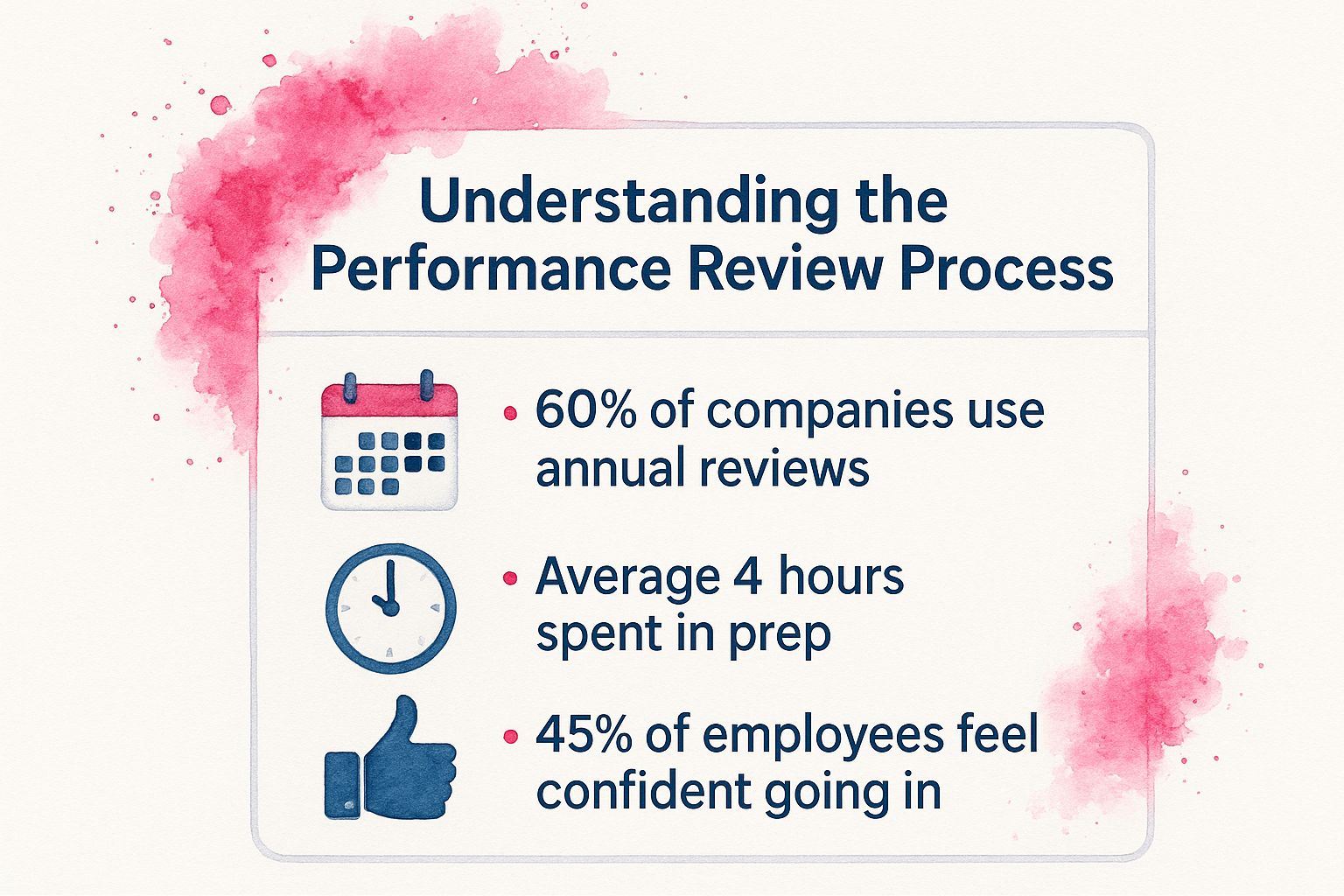Preparing for Performance Review: Top Tips to Succeed
Max
Let’s be honest, preparing for a performance review isn’t just another task on your to-do list. It’s an ongoing process. The best way to nail it is by continuously tracking your achievements, challenges, and contributions all year long. This transforms the review from a stressful memory test into a simple, confident summary of your hard work.
Move Beyond Last-Minute Review Prep
We’ve all been there. The review is a week away, and you’re frantically digging through old emails and project files, trying to piece together what you accomplished six months ago. This last-minute scramble is a recipe for an underwhelming meeting. It puts you on the defensive and can make the whole thing feel more like an interrogation than a real conversation about your growth.
To truly make an impact, you need to ditch that reactive approach. The secret is to start treating your performance like a living document. Whether it’s a simple file on your desktop, a dedicated notebook, or a board in your favorite project management app, get in the habit of logging your wins, learning moments, and contributions as they happen. It’s a small change that completely shifts the dynamic.
The Problem with Traditional Reviews
Many companies are still playing catch-up when it comes to modern performance management. This infographic really drives home how many organizations handle reviews and, more importantly, how employees feel about the process.

The data clearly shows a disconnect. Most companies stick to annual reviews, yet less than half of employees feel confident going into them. That’s a huge gap, and it highlights just how critical it is to take preparation into your own hands.
Adopt a Proactive Preparation Mindset
Switching to a continuous preparation model does more than just make your life easier. It sends a powerful message to your manager: you’re self-aware, organized, and deeply invested in your professional development year-round, not just when your review is on the calendar.
This shift from a one-time event to a continuous habit is crucial for modern professionals. Instead of cramming for a test, you’re building a portfolio of evidence that showcases your value over time. To help illustrate this, let’s compare the old way of thinking with this more proactive approach.
Shift from Traditional to Continuous Preparation
| Preparation Aspect | Traditional (Last-Minute) Approach | Modern (Continuous) Approach |
|---|---|---|
| Timing | Frantic scramble a few days before the review. | Consistent, weekly or bi-weekly updates throughout the year. |
| Evidence | Relies on memory, leading to forgotten accomplishments. | Based on a detailed log of projects, data, and feedback. |
| Mindset | Reactive and defensive. | Proactive and confident. |
| Conversation | Manager-led, often feels like an interrogation. | Collaborative, a two-way discussion about growth. |
| Outcome | Missed opportunities, surface-level discussion. | Comprehensive, data-backed conversation leading to clear goals. |
Moving to the modern column puts you in the driver’s seat. You’re not just a passenger in your own career development; you’re actively steering it. This proactive stance ensures you lead the conversation with confidence and clarity.
This is especially important because so many companies are still rooted in tradition. A staggering 71% of companies still conduct annual performance reviews, making them a major checkpoint in your career. With managers already spending an average of 210 hours a year on this process, coming in prepared and organized makes their job easier and makes you look like a star.
To make this continuous tracking a reality, you’ll need to build the habit. Implementing some effective time management strategies can be a game-changer, helping you carve out small pockets of time to update your records. And for more advice on thriving in a distributed team, our guide on https://remotefirstjobs.com/blog/remote-work-best-practices is packed with more valuable tips.
Build Your Narrative with Concrete Evidence

When you walk into a performance review, your opinion of your work is only half the story. The other, more convincing half? That’s the hard evidence you bring to the table.
A powerful narrative isn’t built on vague statements like, “I’m a good team player.” It’s built on a solid foundation of concrete examples, measurable results, and tangible proof that showcases your real value. Think of it like a lawyer building a case—every claim you make needs to be backed by irrefutable proof.
Your goal is to shift the conversation from what you do to the impact you create. This is how you turn a standard review into a compelling argument for your career growth.
Quantify Your Accomplishments
Numbers don’t lie. Whenever you can, attach a metric to your achievements. This gives your manager a clear picture of the scale and significance of your contributions in a way that words alone just can’t. Vague statements are easily forgotten, but hard data makes a lasting impression.
For instance, instead of saying, “I improved the social media campaign,” get specific. Try something like, “I led the Q3 social media campaign, which drove a 15% increase in engagement and a 10% growth in our follower count.” See the difference? The second version is specific, measurable, and tied directly to business goals.
Here are a few places to look for those all-important numbers:
- Efficiency Gains: Did you streamline a process that saved the team time? How many hours per week?
- Revenue or Sales: Did your work lead to a new client or an upsell? What was the dollar amount?
- Cost Savings: Did you find a way to cut costs or negotiate a better deal for the company?
- Project Completion: Did you wrap up a project ahead of schedule? By how many days or weeks?
Key Takeaway: Data provides an objective measure of your success. Framing your achievements with numbers removes subjectivity and makes your impact undeniable, which is crucial when preparing for a performance review.
Gather Qualitative Evidence and Feedback
Of course, not everything that matters can be measured with a number. That’s where qualitative evidence—like glowing feedback from colleagues or specific examples of your problem-solving skills—comes in. These stories add the color and context that bring your performance narrative to life.
Get in the habit of actively saving positive feedback. Did a coworker send you a Slack message thanking you for your help on a tough project? Did a client email your manager to praise your work? Screenshot it. Save it. Create a dedicated folder for these kudos. This isn’t about ego; it’s about collecting third-party validation that speaks volumes.
This is especially critical in a remote setup. Since your manager can’t see you collaborating in person, showing that you’re a great teammate is vital. As we know, building trust in virtual teams is a skill in itself, and having proof of your ability to do it well is incredibly powerful.
Document Your Problem-Solving Abilities
Your value isn’t just about ticking boxes on your to-do list. It’s also about how you handle the curveballs. Think back over the past year and pinpoint a few moments where you had to think on your feet or untangle a complex problem.
Document these instances like you’re telling a story. It’s a simple but effective formula:
- The Challenge: What was the problem?
- Your Action: What specific steps did you take to solve it?
- The Outcome: What was the positive result of your actions?
Maybe a key team member left unexpectedly right in the middle of a critical project. Your story could be about how you stepped up, reallocated tasks, and kept the project on track, preventing a major delay and saving the day. This is how you demonstrate initiative, resilience, and leadership potential—all qualities that get you noticed.
Craft an Honest and Effective Self-Assessment
Let’s be real: your self-assessment is probably the most powerful piece of paper (or digital doc) in your entire review. It’s your first and best chance to tell your story, highlight what you’ve accomplished, and steer the conversation where you want it to go.
Writing a great self-review is a balancing act. You have to confidently showcase your wins without sounding arrogant, while also showing you’re self-aware enough to know where you can grow.

The goal here is to be both honest and strategic. This isn’t the time for false modesty (“Oh, it was nothing…”) or for over-the-top bragging. It’s about connecting the dots between your day-to-day work and the company’s larger goals, proving you get it.
Structure Your Wins with the STAR Method
To keep your accomplishments from sounding like a boring laundry list, you need a story. The STAR method (Situation, Task, Action, Result) is a fantastic way to frame your impact with real context. It pushes you beyond just saying what you did and gets you to explain why it actually mattered.
Here’s what that looks like in practice for, say, a remote project manager:
- Situation: Our team was all over the place after we went fully asynchronous. People were working in silos, and deadlines were slipping.
- Task: I needed to get everyone on the same page, improve project visibility, and get our timelines back on solid ground.
- Action: I researched a few project management tools, picked the best fit, and got buy-in to implement it. I then built out some standard templates and ran a couple of training sessions so everyone knew how to use it.
- Result: The very next quarter, we saw a 30% drop in missed deadlines. A quick team survey also showed a 45% improvement in how clear and connected everyone felt to our goals.
See the difference? That structure turns a generic “I improved our project management” into a data-driven story of success your manager can easily understand and champion.
Discuss Growth Areas with Proactive Solutions
Talking about where you need to improve isn’t a sign of weakness—it’s a sign of maturity. No one is perfect. The key is to frame your development goals constructively and show you’ve already thought about a solution. Never just point out a flaw without offering a plan.
Your self-assessment is a conversation starter, not a confession. When discussing development areas, own them, but immediately pivot to your plan for growth. This positions you as a proactive, solution-oriented employee.
So, instead of a flat statement like, “I need to get better at public speaking,” you frame it strategically:
“While I’m comfortable leading our internal team meetings, I’ve noticed my presentation skills could be sharper when I’m in front of larger, cross-departmental groups. I’ve already looked into a few public speaking workshops and would love to discuss enrolling in one this year. I think it would really help me support our upcoming product launches more effectively.”
This approach shows you’re self-aware, you’ve taken initiative, and you’re tying your personal growth directly to the company’s success. It’s a skill that pays off in reviews and interviews alike. For more on this, our article on video interview preparation has some great advice on presenting yourself with confidence.
Let Technology Do the Heavy Lifting for You
When you’re working remotely, you don’t have the luxury of your manager walking by your desk and seeing you grind away on a tough project. Your hard work is often invisible. This is where technology becomes your best friend—not just for getting the job done, but for proving how well you’re doing it.
A little bit of smart, ongoing documentation completely changes the game. Instead of frantically digging through old emails and Slack threads a week before your review, you can have a neatly organized file of your accomplishments ready to go.
Start Your “Kudos File” Today
The secret to stress-free review prep is a central place to track all your wins. Think of it as a “kudos file”—a running log where you drop achievements, positive feedback, and project results as they happen. It’s not about adding another chore to your list; it’s about making your life easier later.
You don’t need fancy software. A simple page in Notion or Evernote is perfect for this. Set a reminder to update it every Friday afternoon.
Here’s what you should be logging:
- Positive Feedback: Screenshot that glowing Slack message from a colleague or the “great job” email from a client.
- Project Wins: Did you finish a major task ahead of schedule or under budget? Make a quick note of it.
- Hard Numbers: Log any metrics you moved the needle on. A percentage increase in sign-ups or a reduction in support tickets are pure gold.
- Problem-Solving Moments: Briefly jot down a story about a challenge you tackled. What was the problem, what did you do, and what was the outcome?
This simple habit ensures nothing important slips through the cracks. Come review time, you’ll have a rich, detailed record of your contributions. For more inspiration, check out our guide to the best remote work tools.
Turn Your Everyday Tools into an Evidence Locker
Your daily project management and communication apps are treasure troves of proof. In tools like Asana or Trello, every completed task and successful project board is a data point on the timeline of your achievements.
In Slack, you can save key messages or even create a private channel where you forward positive comments and wins to yourself.
Don’t just do the work—document it. A task marked “done” in Asana is evidence. A “thank you!” in Slack is a testimonial. The key is to get into the habit of capturing these small moments before they get buried.
This data-driven approach is becoming the standard. The global performance management market is projected to hit $9.79 billion by 2033, with a huge chunk of that growth fueled by AI. With 75% of global knowledge workers already using AI, companies are moving toward a more analytical way of evaluating performance. Tapping into this trend for your own prep work isn’t just smart—it’s essential for standing out.
Set the Stage for a Constructive Conversation

All that hard work gathering evidence and crafting your self-assessment has led you to this moment: the performance review itself. But don’t think of this as just a finish line. It’s really a launchpad for your future. The trick is to shift the meeting from a simple, passive update into a genuinely collaborative dialogue about where your career is headed.
Your preparation gives you the data and the confidence. Now, the final piece is to strategize how you’ll use that prep to guide the conversation. It’s about thinking through potential questions, framing your own, and having clear goals for what you want to walk away with.
Anticipate Your Manager’s Perspective
Before the meeting, take a moment to see things from your manager’s point of view. What are their biggest priorities right now? What team or company-wide goals are they laser-focused on? Thinking this way helps you connect your wins directly to what they value most, making your contributions feel much more significant.
Think about the questions they’re likely to ask, especially based on your self-assessment and recent projects. They’ll probably ask about:
- Your biggest challenges over the last period.
- How you intend to address any development areas.
- What kind of resources or support you need to knock it out of the park.
Having thoughtful answers ready shows you’re not just showing up—you’re engaged and thinking ahead. It also gives you the power to steer the conversation toward topics you want to cover, like your career path or taking on new responsibilities.
Frame Your Questions Thoughtfully
A performance review needs to be a two-way street. The questions you ask are every bit as important as the answers you give. Asking sharp, insightful questions shows you’re not just a passive employee; you’re committed to your growth and future with the company.
To make sure your review is a genuine exchange, check out some tips on How to Ask Better Questions That Transform Conversations. It can help turn a standard meeting into a far more meaningful discussion.
Ditch the generic questions and try framing them around your growth and future impact:
- “Based on my performance, what do you see as the next logical step for my career here?”
- “What’s the single most important skill you think I should focus on in the next six months to bring more value to the team?”
- “Looking ahead, what are the biggest challenges you see for our team, and how can I best position myself to help us succeed?”
Questions like these prove you’re thinking beyond your current role and are invested in the team’s collective success. This kind of strong questioning is a key part of building a better dialogue, which is essential for improving remote employee engagement and forging a solid relationship with your manager.
This approach has never been more critical, especially when you consider that a staggering 95% of managers are unhappy with their company’s current performance review process. By coming in ready for a real conversation, you help your manager turn what can be a clunky, formal process into something genuinely productive.
Even with the best prep in the world, a performance review can still throw you a curveball. The trick is to stay composed and treat every single question—even the really tough ones—as a chance to have a productive, two-way conversation.
Let’s break down how to handle some of those common, slightly awkward situations with total professionalism.
What to Do with Unexpected Feedback
If your manager brings up some negative feedback you weren’t expecting, your gut reaction might be to jump on the defensive. Don’t. Take a deep breath and genuinely listen to what they’re saying.
The best move here is to ask for specifics to make sure you’re both on the same page. You could say something like, “Thanks for bringing that to my attention. So I can really get a handle on it, could you walk me through an example of when that happened?”
This shifts the dynamic immediately. You’re showing you’re open to the feedback, not looking for a fight. It’s also completely acceptable to ask for a moment to process the information and schedule a follow-up meeting to talk through an action plan.
When You Don’t Agree with an Assessment
So, what happens if your manager says something you flat-out disagree with? This is exactly why you did all that prep work beforehand.
Calmly present your point of view, but make sure you back it up with the specific, data-driven examples you’ve already gathered.
Frame it as a discussion, not a confrontation. For instance: “I can see that perspective. From where I was sitting, I viewed my impact on that project a bit differently. I actually have some numbers on the client engagement metrics I drove that I’d be happy to share.”
The goal here isn’t to “win” an argument. It’s about getting to a shared understanding. When you present your evidence calmly, you keep the conversation grounded in facts, not feelings.
When the talk shifts toward what’s next for you, it’s your time to shine and prove you’re thinking about the bigger picture. Answering questions about your future goals isn’t just about what you want to do; it’s about showing you know how to set goals effectively and how your personal growth aligns with where the company is headed.
Ready to find a role at a company that truly values growth and constructive feedback? Remote First Jobs lists over 40,000 verified, spam-free remote positions. Find your next opportunity at https://remotefirstjobs.com.


